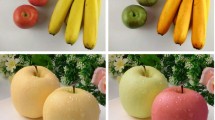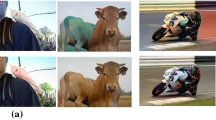Abstract
This paper introduces a semantic-segmentation guided image recoloring approach of digitized art paintings to enhance the color perception of color- blind people that suffer from protanopia and deuteranopia. Semantic segmentation using transfer learning between natural images and art paintings is applied to extract annotated color information. By using a standard technique, the annotated colors are transformed to simulate the effects of protanopia and deuteranopia. Then, a specialized objective function is minimized to recolor only the colors that are significantly different from the respective simulated ones, because these colors are perceived as confusing by the color blind. The effectiveness of the proposed method is demonstrated through its comparison with other algorithms in several experimental cases.
Access this chapter
Tax calculation will be finalised at checkout
Purchases are for personal use only
Similar content being viewed by others
References
Doliotis, P., Tsekouras, G.E., Anagnostopoulos, C.N., Athitsos, V.: Intelligent modification of colors in digitized paintings for enhancing the visual perception of color-blind viewers. In: The Proceedings of the 5th International Conference on Artificial Intelligence Applications and Innovations, pp. 293–301 (2009)
Girshick, R.: Fast R-CNN. In: The Proceedings of the 2015 IEEE International Conference on Computer Vision (ICCV), Santiago, Chile, pp. 1440–1448 (2015)
Girshick, R., Donahue, J., Darrell, T., Malik, J.: Rich feature hierarchies for accurate object detection and semantic segmentation. In: The Proceedings of the 2014 IEEE Conference on Computer Vision and Pattern Recognition (CVPR), Columbus, OH, USA, pp. 580–587 (2014)
Gonthier, N., Gousseau, Y., Ladja, S., Bonfait, O.: Weakly supervised object detection in artworks. In: The Proceedings of the 2018 European Conference on Computer Vision (ECCV 2018), Munich, Germany, pp. 692–709 (2018)
Hassan, M.F., Paramesran, R.: Naturalness preserving image recoloring method for people with red–green deficiency. Sig. Process. Image Commun. 57, 126–133 (2017)
He, K., Zhang, X., Ren, S., Sun, J.: Deep residual learning for image recognition. In: The Proceedings of the 2016 IEEE Conference on Computer Vision and Pattern Recognition (CVPR), Las Vegas, NV, USA, pp. 770–778 (2016)
Ho, G.W.: Color, vision, and art: teaching, learning, and making art with color blind awareness. M.Sc. thesis, University of Florida (2014)
Huang, J-B., Chen, C.S., Jen, T.S., Wang, S.J.: Image recolorization for the color blind. In: The Proceedings of the 2009 IEEE International Conference on Acoustics, Speech and Signal Processing (ICASSP 2009), pp. 1161–1164 (2009)
Huang, J.-B., Tseng, Y.-C., Wu, S.-I., Wang, S.-J.: Information preserving color transformation for protanopia and deuteranopia. IEEE Signal Process. Lett. 14(10), 711–714 (2007)
Johnston-Feller, R.: Color Science in the Examination Museum Objects. The Getty Conservation Institute, Los Angeles (2001)
Krizhevsky, A., Sutskever, I., Hinton, G.E.: ImageNet classification with deep convolutional neural networks. Commun. ACM 60(6), 84–90 (2017)
Marmor, M.F., Lanthony, P.: The dilemma of color deficiency and art. Surv. Ophthalmol. 45(5), 407–414 (2001)
Price, K.V., Storn, R.M., Lampinen, J.A.: Differential Evolution: A Practical Approach to Global Optimization. Springer, Berlin (2005)
Rani, S.S., Rajeev, R.: Colour transformation for deuteranopic viewers. Int. J. Control Theor. Appl. 9(10), 4527–4535 (2016)
Ren, S., He, K., Girshick, R., Sun, J.: Faster R-CNN: towards real-time object detection with region proposal networks. IEEE Trans. Pattern Anal. Mach. Intell. 39(6), 1137–1149 (2017)
Ribeiro, M., Gomes, A.J.P.: Recoloring algorithms for colorblind people: a survey. ACM Comput. Surv. 52(4), 72:1–72:37 (2019)
Stockman, A., Sharpe, L.T.: The spectral sensitivities of the middle- and long-wavelength-sensitive cones derived from measurements in observers of known genotype. Vision. Res. 40, 1711–1737 (2000)
Tsekouras, G.E., Chatzistamatis, S., Anagnostopoulos, C.N., Makris, D.: Color adaptation for protanopia using differential evolution-based fuzzy clustering: a case study in digitized paintings. In: The Poceedings of the 2018 IEEE Conference on Evolving and Adaptive Intelligent Systems (EAIS 2018), Rhodes Island, Greece (2018)
Uijlings, J.R.R., van de Sande, K.E.A., Gevers, T., Smeulders, A.W.M.: Selective search for object recognition. Int. J. Comput. Vision 104, 154–171 (2013)
Vienot, F., Brettel, H., Mollon, J.: Digital video colourmaps for checking the legibility of displays by dichromats. Color Res. Appl. 24(4), 243–252 (1999)
Yin, R., Monson, E., Honig, E., Daubechies, I., Maggioni, M.: Object recognition in art drawings: transfer of a neural network. In: The Proceedings of the 2016 IEEE International Conference on Acoustics, Speech and Signal Processing (ICASSP), Shanghai, China (2016)
Acknowledgments
This research is co-financed by Greece and the European Union (European Social Fund-ESF) through the Operational Programme “Human Resources Development, Education and Lifelong Learning 2014–2020” in the context of the project “Color perception enhancement in digitized art paintings for people with Color Vision Deficiency” (MIS 5047115).
Author information
Authors and Affiliations
Corresponding author
Editor information
Editors and Affiliations
Rights and permissions
Copyright information
© 2020 The Editor(s) (if applicable) and The Author(s), under exclusive license to Springer Nature Switzerland AG
About this paper
Cite this paper
Chatzistamatis, S., Rigos, A., Tsekouras, G.E. (2020). Image Recoloring of Art Paintings for the Color Blind Guided by Semantic Segmentation. In: Iliadis, L., Angelov, P., Jayne, C., Pimenidis, E. (eds) Proceedings of the 21st EANN (Engineering Applications of Neural Networks) 2020 Conference. EANN 2020. Proceedings of the International Neural Networks Society, vol 2. Springer, Cham. https://doi.org/10.1007/978-3-030-48791-1_20
Download citation
DOI: https://doi.org/10.1007/978-3-030-48791-1_20
Published:
Publisher Name: Springer, Cham
Print ISBN: 978-3-030-48790-4
Online ISBN: 978-3-030-48791-1
eBook Packages: Computer ScienceComputer Science (R0)




